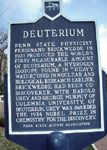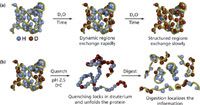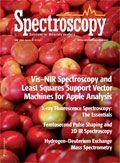Hydrogen–Deuterium Exchange Mass Spectrometry
A detailed look at H–D exchange mass spectrometry including the history of the technique, the exchange process itself, and how the current state of the art provides insights into complex protein structures and their dynamics.

Mass spectrometric measurements often begin with the determination of the masses of ions, assuming that these are set and stable. But we can also monitor the progress of mass shifts purposefully created in our experiments, and derive reaction kinetic information. For example, labile hydrogen (H) atoms in molecular and ionic structures can be replaced with deuterium (D), and the mass shifts and kinetics can be followed as the measured ion masses progressively increase. In its current state of development, H–D exchange mass spectrometry provides insights into complex protein structures and their dynamics through the study of the rates of exchange under various conditions.
It starts with the basics; many of us learn about hydrogen (H), deuterium (D), and tritium (T) in our first chemistry classes. Tritium is radioactive, but hydrogen and deuterium are not. The difference between hydrogen and deuterium, of course, is the presence of the neutron in the nucleus of the latter. Although the relative shift in mass between H (mass of 1.007825 Da) and D (mass of 2.014102 Da) is the largest of the isotopes, the discovery of deuterium occurred later than many other isotopes and, oddly enough, was not accomplished directly through experiments with mass spectrometers. The manuscript announcing the discovery of deuterium by Urey, Brickwedde, and Murphy (1) carries a date of December 5, 1931, and was published in early 1932 (1). What made that deuterium different was that extra particle in the nucleus. The publication "The Existence of a Neutron" by Chadwick carries a date of May 10, 1932, and was published June 1 of that year (2) following a brief announcement of results written on February 17 and published February 27, 1932 (3). Nobel prizes for these discoveries were awarded in 1934 and 1935, respectively (remember that Aston's Nobel prize for mass spectrometry [MS] was in 1922). The extraordinary sequence of synergistic discoveries was the result of both impassioned competition and serendipity (4–6). The understanding that provided the basis for modern MS was also used in the development of atomic weapons in only a little over two decades from discovery. These bits of history should not be relegated to historical markers (Figure 1). The generation of scientists who witnessed this series of astounding discoveries has largely passed, but the processes and sometimes the serendipity of the scientific process (4) replays within each succeeding generation.

Figure 1: Marker on the campus of Pennsylvania State University that celebrates the accomplishments of physics professor F.G. Brickwedde (then at the National Institute of Standards and Technology [NIST]) in preparing samples analyzed to provide evidence supporting the discovery of deuterium. Three years after the discovery, heavy water (D2O) was being produced on an industrial scale at a hydroelectric facility in Norway. This is one of probably only a few markers devoted to isotopes in the United States.
Replacing Hydrogen with Deuterium
Changes in physical parameters that occur as a result of the replacement of hydrogen with deuterium have been characterized. The kinetic isotope effect, which is the change in reaction rate resulting from the replacement, has been measured in many systems. New areas of applications constantly surface. For one example, deuterium-modified analogs of pharmaceutical drugs have been patented in the past five years. These analogs are being explored in the hope that improvements in the drug's metabolic properties can be achieved. But how can we use deuterium specifically in MS, when the mass shift allows us to track hydrogen–deuterium placement in ions and ion fragments? Even within the constraints of MS, we could choose from literally thousands of applications. Two studies provide the foundation needed here. The first is the classic publication that used deuterium labeling to establish the existence of the tropylium cation (7). The mass spectra of alkylbenzenes with deuterium replacing hydrogen in specific locations, being composed of ions of different mass based on the incorporation of deuterium, were interpreted as a group to show that the seven hydrogens in the C7H7+ ion were indistinguishable, and that the ion was therefore a tropylium symmetric structure. This exemplary publication highlights the use of strategic deuterium labeling to elucidate fragmentation reactions of organic ions.
The second publication (8) built upon the uses of trimethylsilyl (TMS) derivatization. This derivatization reagent had been developed in gas chromatography (GC) and gas chromatography–mass spectrometry (GC–MS) because the derivatives were stable and volatile and the original molecules were not. The TMS group is –Si (CH3)3. As an interpretive example, the number of derivatized hydroxyl groups in a molecule could be determined because each hydroxyl hydrogen would be replaced by the TMS group, and the number of groups was therefore apparent by a simple count of the number of losses of trimethylsilanol molecules in the resultant electron ionization mass spectrum. But there are interpretive difficulties when the structure of the original molecule becomes more complicated. The use of perdeutero-TMS derivatives (–Si (CD3)3) provides information (via tracking the deuterium atoms) that helps to avoid the uncertainties. The basic mass shifts apparent in the compared mass spectra are simple: a 9-Da shift in mass represents the intact TMS group, and a 6-Da shift is the loss of a methyl (deuteromethyl) group. Tracing the deuterium in the mass spectra of various molecules led to the deduction that rearrangement reactions reveal "the existence of coiled or wound chains in the vapor phase." This prescient statement hints at a higher-order structure for ions that can be discerned through MS experiments.
Higher-Order Structures and Derivatization
In 45 years, the study of higher-order structures and their dynamics was made possible with progressively more sophisticated analyses, and tools such as new ionization methods and ion dissociation processes. These methods couple with H–D exchange MS, and in a sense a return to the basic idea of derivatization. The derivative is the deuterium atom and the mass shift is followed with ease. Ideally, derivatization by replacement of hydrogen with deuterium does not change the intrinsic properties of the molecule, and we can discern progressively more complicated structures in both the condensed and the gas phase by tracing the deuterium. A number of reviews are available that provide background on the method, its modeling, the display and interpretation of the datasets, and the conclusions that can be drawn.
The Exchange Process
The observation that certain hydrogen atoms in proteins will exchange with deuterium when the protein is exposed to a D2O solvent was initially established in the 1950s. Hydrogen atoms connected to the amide backbone of the protein (labile hydrogen) exchange with deuterium in buffered D2O solvent at a varying rate depending on the accessibility of the amide bond to the solvent (9), and the dynamics of the protein structure. Hydrogen bonding, for example, within the structure itself slows the rate of exchange. Side-chain exchangeable hydrogen in residues such as Asn (-CONH2), Asp (-COOH), Ser (-OH), Cys (-SH), or Lys (-NH2) exchanges at much faster rates, again depending on location in the molecule. The exchange reactions proceed at rates that vary from fractions of a second to days. Interrogating the results at multiple points during that period provides a picture of the structure and its dynamics. Nuclear magnetic resonance (NMR) spectrometry was used to study the structures for many years. However, MS follows the mass shift that results from the exchange with great clarity, and requires less sample. The early 1990s (10,11) saw early publications that foreshadowed the potential of MS in measuring rates and in elucidating structures and their dynamics, based on the exchange of deuterium for hydrogen.
Figure 2 (top) illustrates the exchange process and its different time scales, showing the immediate exchange reactions as well as the longer term exchanges in the more inaccessible parts of the complex structure. The rates of the hydrogen exchange are determined by pH, temperature, accessibility of the region to solvent, and hydrogen bonding. The first two factors are controlled in the experiment, and the latter two are the factors that provide information about the structure of the protein. The times required for exchange may vary over as much as eight orders of magnitude, from fractions of a second to days. If one were to examine molecular ions in the mass spectra at a series of times after the onset of the exchange reaction (taking out samples as a function of time, and quenching each to stop the exchange), and compare the observed masses to the ions in the unexchanged spectrum, the molecular ions for rapidly exchanged regions would display an immediate shift to higher masses. Longer-term exchanges would appear as the molecular ion masses progressed sequentially to higher values. This thought experiment is a bit more complex in reality because the molecular ions exhibit an isotopic envelope simply by virtue of their higher mass and the contributions of other isotopes. The progression to higher masses "distorts" that envelope as the exchange reactions proceed. As one simple example of data processing, the envelope can be modeled based on the known empirical formula for the ion considered. The deuterium exchange can be seen as the progressive mass spectra are compared with the immediately preceding spectra. The exchange can be monitored through the centroided mass of a group of peaks, or by dissecting each peak (including at higher mass resolving power). A common data display is called a deuterium uptake plot. Software to process the voluminous data generated even when looking at only the molecular ions is widely available; below we discuss how the data production ramps rapidly upward.

Figure 2: (a) The two exchange regimes, which are the rapid side-chain and dynamic region exchanges, and then the more slowly exchanging structured regions. (b) The exchange reactions are quenched by lowering the pH and temperature. This sample can be analyzed directly or can be digested using the usual methods into smaller peptide lengths that can be separated and analyzed. Figure adapted with permission from reference 23.
Figure 2b illustrates the quenching reaction that stops the exchange reaction. Quenching usually occurs when the pH and the temperature are dropped. This change in conditions may not be perfect, and some back exchange can occur, especially for the very readily exchanged hydrogen–deuterium. The back exchange must also be considered when the sample is further processed for other mass spectral measurements. Figure 2b shows that the sample can be unfolded and then digested using relatively standard techniques. Pepsin or other proteases are used for proteolysis, and the quenched exchange must be maintained through the process. Various forms of liquid chromatography (LC) are used to separate the individual peptides, which are then analyzed by MS, often with electrospray ionization (ESI). The extent of deuterium exchange can then be established in each of the peptide fragments by comparison of mass expected and mass observed, illustrating the progressively more expansive data processing needs.
Exchange can be assessed, then, in molecular ions or in smaller parts derived from the larger structure. On reflection, it should be obvious that the former represents the total of all exchange reactions occurring, and may not provide information relevant to specific regions of a larger structure. Probing the exchange reactivity in regions is made possible by the proteolysis illustrated in Figure 2b. Is it possible to determine the amount of deuterium exchange into individual amino acids or small chains of 2–5 amino acids? Certainly being able to assemble such information, residue by residue, over an entire structure would provide a detailed examination of its structure. The mass shift in each ion should be readily discernible, so the problem becomes how to take ionic chains of amino acids and dissociate them. Collision-induced dissociation (CID) is a mainstay of MS-MS, which has been used to sequence peptides. But it is also known that hydrogen can scramble within the ion as a result of the CID energization, rendering this specific process unsatisfactory. Studies show that electron-capture dissociation and electron-transfer dissociation can, under some conditions, provide the requisite dissociation without scrambling. The extent of H–D exchange can then be probed residue by residue. For proteins containing hundreds or thousands of residues, the management of the data can become a complex problem. Insights into how to process and interpret this data are continually being developed and refined (12,13).
Conclusions
Reviews over the past 10 years reflect the development of the method, but also different perspectives as it engages the attention of other research communities. Topics covered in the reviews include mathematical modeling of the kinetics, the display and interpretation of the datasets, new approaches and challenges, including automated workflows and the incorporation of microfluidics, and finally, the breadth and meaning of the conclusions (15–19). The method is described in general science articles (20) and even a few videos can be found online (21). The information available from H–D exchange MS extends to studies of changes in protein structure as the result of binding to an inhibitor, protein–protein interactions, and folding and unfolding dynamics. All of this information is revealed in the plots of deuterium uptake with time for the protein as a whole, and for its subregions. Nothing in MS stays simple for long, and H–D exchange MS is a perfect example of a simple concept amplified through insightful experiments that is now being used by a broad range of scientific research and application communities. As this column was being prepared, the obituary for Virgil Woods appeared in the Journal of the American Society for Mass Spectrometry (22). Dr. Woods was involved in the automation of H–D exchange MS dating back to 2000. As in much of mass spectrometry today, the capabilities that we sometimes take for granted today can be traced directly to the insight, capabilities, and persistence of earlier researchers.
References
(1) H.C. Urey, F.G. Brickwedde, and G.M. Murphy, Phys. Rev. 39, 164–165 (1932).
(2) J. Chadwick, Proc. R. Soc. London, 136, 692–708 (1932).
(3) J. Chadwick, Nature I29, 312 (February 27, 1932).
(4) F.G. Brickwedde, Phys. Today35(9), 34–39 (1982).
(5) N. Feather, Contemp. Phys. 15(6), 565–572 (1974).
(6) J. Reader and C.W. Clark, Phys. Today 66(3), 44–49 (2013).
(7) P.N. Rylander, S. Meyerson, and H.M. Grubb, J. Amer. Chem. Soc. 79, 842–846 (1957).
(8) J.A. McCloskey, R.N. Stillwell, and A.M. Lawson, Anal. Chem. 40, 233–236 (1968).
(9) S.W. Englander and N.R. Kallenbach, Quart. Rev. Biophys. 16, 521-655 (1983).
(10) V. Katta and B.T. Chait, Rapid Commun. Mass Spectrom. 5(4), 214–217 (1991).
(11) G. Thévenon-Emeric, J. Kozlowski, Z. Zhang, and D.L. Smith, Anal. Chem. 64, 2456–2458 (1992).
(12) D.D. Weis, T.E. Wales, J.R. Engen, M. Hotchko, and L.F. Ten Eyck, J. Amer. Soc. Mass Spectrom. 17, 1498–1509 (2006).
(13) J. Zhang, P. Ramachandran, R. Kumar, and M.L. Gross, J. Amer. Soc. Mass Spectrom. 24, 450–453 (2013).
(14) J.D. Venable, W. Scuba, and A. Brick, J. Amer. Soc. Mass Spectrom. 24, 642–645 (2013).
(15) J. Engen and D.H. Smith, Anal. Chem. 73, 256A–265A (2001).
(16) T. Wales and J. Engen, Mass Spectrom. Rev. 25, 158–170 (2006).
(17) D.D. Weis, S. Kaveti, Y. Wu, and J.R. Engen, "Probing protein interactions using hydrogen-deuterium exchange mass spectrometry," in Mass Spectrometry of Protein Interactions, K.M. Downard, Ed. (John Wiley and Sons, Hoboken, New Jersey, 2007), pp. 45–62.
(18) X. Yan and C.S. Maier, Meth. Molec. Biol. 492, 255–171 (2009).
(19) L. Konermann, J. Pan, and Y.H. Liu, Chem. Soc. Rev. 40, 1224–1234 (2011).
(20) http://cen.acs.org/articles/90/i17/Easing-Toil-Hydrogen-Exchange.html.
(21) http://www.jove.com/video/3602/amide-hydrogendeuterium-exchange-maldi-tof-mass-spectrometry-analysis; http://www.scivee.tv/node/6576.
(22) Y. Hamuro, J. Amer. Soc. Mass Spectrom. 24, 650–651 (2013).
(23) http://mvsc.ku.edu/content/hydrogen-deuterium-exchange-mass-spectrometry.
Kenneth L. Busch at a theoretical body mass of 70 kg (http://chemistry.about.com/od/lecturenoteslab1/a/Elemental-Composition-Of-The-Human-Body-By-Mass.htm), contains about 7 kg of hydrogen. With a mass abundance for deuterium of 0.0312%, he therefore contains about 2.184 g of deuterium. Since all deuterium is thought to be originally formed in the Big Bang, the presence of these multibillion-year-old atoms can be invoked to explain his grey hair and cantankerous nature. This column is the sole responsibility of the author, who can be reached at wyvernassoc@yahoo.com.

Kenneth L. Busch

LIBS Illuminates the Hidden Health Risks of Indoor Welding and Soldering
April 23rd 2025A new dual-spectroscopy approach reveals real-time pollution threats in indoor workspaces. Chinese researchers have pioneered the use of laser-induced breakdown spectroscopy (LIBS) and aerosol mass spectrometry to uncover and monitor harmful heavy metal and dust emissions from soldering and welding in real-time. These complementary tools offer a fast, accurate means to evaluate air quality threats in industrial and indoor environments—where people spend most of their time.
NIR Spectroscopy Explored as Sustainable Approach to Detecting Bovine Mastitis
April 23rd 2025A new study published in Applied Food Research demonstrates that near-infrared spectroscopy (NIRS) can effectively detect subclinical bovine mastitis in milk, offering a fast, non-invasive method to guide targeted antibiotic treatment and support sustainable dairy practices.